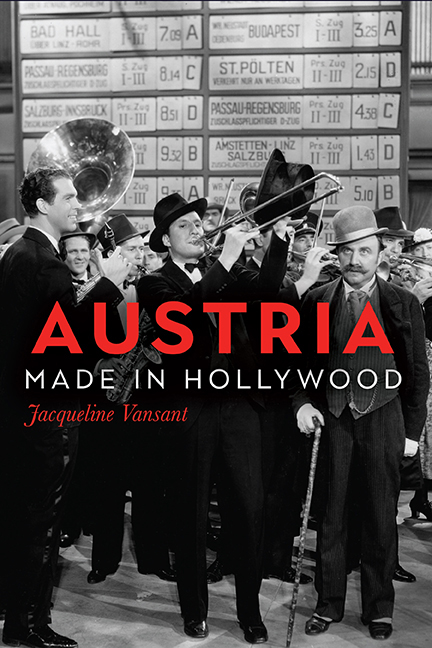Book contents
- Frontmatter
- Contents
- List of Illustrations
- Acknowledgments
- Introduction
- 1 Erich Stroheim, His Austria(ns), and Their US Contexts
- 2 Cross-Cultural Encounters of the Intimate Kind: Hollywood's Americans in Love with Austria(ns), 1932–60
- 3 The Empire Strikes Back: Imperial Austria Fights Nazis, 1938–41
- 4 Reflections and Refractions of the Anschluss on the Hollywood Screen, 1941–42
- 5 Confronting and Escaping History: The Cardinal (1963) and The Sound of Music (1965)
- Conclusion: Hollywood's Austria—Its Past, Present, Future
- Appendix: Hollywood Films Set in Austria
- Notes
- Bibliography
- Index
5 - Confronting and Escaping History: The Cardinal (1963) and The Sound of Music (1965)
Published online by Cambridge University Press: 04 April 2019
- Frontmatter
- Contents
- List of Illustrations
- Acknowledgments
- Introduction
- 1 Erich Stroheim, His Austria(ns), and Their US Contexts
- 2 Cross-Cultural Encounters of the Intimate Kind: Hollywood's Americans in Love with Austria(ns), 1932–60
- 3 The Empire Strikes Back: Imperial Austria Fights Nazis, 1938–41
- 4 Reflections and Refractions of the Anschluss on the Hollywood Screen, 1941–42
- 5 Confronting and Escaping History: The Cardinal (1963) and The Sound of Music (1965)
- Conclusion: Hollywood's Austria—Its Past, Present, Future
- Appendix: Hollywood Films Set in Austria
- Notes
- Bibliography
- Index
Summary
WHEN OTTO PREMINGER AND ROBERT WISE resurrected Austria at the time of the Anschluss in The Cardinal (1963) and The Sound of Music (1965) respectively, they had vastly different takes on this period of history, both from each other and from the makers of So Ends Our Night, They Dare Not Love, and Once upon a Honeymoon. Except for wanting to make a successful film, their motives could not have been more divergent. Shortly before the film's premiere Preminger stated in a New York Times article from December 8, 1963, that he liked “‘to make pictures about the interesting themes and topics of the day.’” In this film he dealt openly with abortion, mixed marriage (Jewish-Catholic), and racism, all burning issues in the sixties. By contrast, in a Times article from November 20, 1966, Wise maintained that he “‘wasn't trying to say a damn thing in “Music”.’” Rather, he was offering movie goers a respite from controversy. Unlike the films discussed in the previous chapter, The Cardinal and The Sound of Music were neither a call to arms nor justification for US involvement in the war.
If the makers of So Ends Our Night, They Dare Not Love, and Once upon a Honeymoon shared a common enemy in the National Socialists, Otto Preminger's and Robert Wise's mutual foe was television. In their divergent takes on Austrian history, the filmmakers engaged in similar techniques and strategies to motivate viewers off their couches and entice them into movie theaters. Preminger and Wise both turned to an age-old practice and worked with source material that had been proven successful. The Cardinal was based on Henry Morton Robinson's 1950s bestselling novel of the same name. Before it was turned into a Hollywood film, the Broadway musical The Sound of Music had enjoyed a three-and-a-half-year run. In addition, both directors employed strategies typical of the sixties. Shot in color with wide-screen technology, The Cardinal and The Sound of Music were among many Hollywood movies filmed at European locations in the sixties. At a time when more Americans were living and traveling in Europe than ever before, such films could prime visitors for a European adventure or provide them with a virtual (return) visit. Travel articles on Austria peppered the New York Times, suggesting the country's desirability.
- Type
- Chapter
- Information
- Austria Made in Hollywood , pp. 113 - 130Publisher: Boydell & BrewerPrint publication year: 2019



